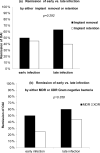Osteosynthesis-associated infection of the lower limbs by multidrug-resistant and extensively drug-resistant Gram-negative bacteria: a multicentre cohort study
- PMID: 36644590
- PMCID: PMC9832304
- DOI: 10.5194/jbji-7-279-2022
Osteosynthesis-associated infection of the lower limbs by multidrug-resistant and extensively drug-resistant Gram-negative bacteria: a multicentre cohort study
Abstract
Purpose: The purpose of this study was the clinical and therapeutic assessment of lower-limb osteosynthesis-associated infection (OAI) by multidrug-resistant (MDR) and extensively drug-resistant (XDR) Gram-negative bacteria (GNB), which have been poorly studied to date. Methods: A prospective multicentre observational study was conducted on behalf of ESGIAI (the European Society of Clinical Microbiology and Infectious Diseases (ESCMID) Study Group on Implant-Associated Infections). Factors associated with remission of the infection were evaluated by multivariate and Cox regression analysis for a 24-month follow-up period. Results: Patients ( ) had a history of trauma (87.7 %), tumour resection (7 %) and other bone lesions (5.3 %). Pathogens included Escherichia coli ( ), Pseudomonas aeruginosa ( ; XDR 50 %), Klebsiella spp. ( ), Enterobacter spp. ( ), Acinetobacter spp. ( ), Proteus mirabilis ( ), Serratia marcescens ( ) and Stenotrophomonas maltophilia ( ). The prevalence of ESBL (extended-spectrum -lactamase), fluoroquinolone and carbapenem resistance were 71.9 %, 59.6 % and 17.5 % respectively. Most patients ( ; 64.9 %) were treated with a combination including carbapenems ( ) and colistin ( ) for a mean of 63.3 d. Implant retention with debridement occurred in early OAI (66.7 %), whereas the infected device was removed in late OAI (70.4 %) ( ). OAI remission was achieved in 29 cases (50.9 %). The type of surgery, antimicrobial resistance and duration of treatment did not significantly influence the outcome. Independent predictors of the failure to eradicate OAI were age years (hazard ratio, HR, of 3.875; 95 % confidence interval, CI95 %, of 1.540-9.752; ) and multiple surgeries for OAI (HR of 2.822; CI95 % of 1.144-6.963; ). Conclusions: Only half of the MDR/XDR GNB OAI cases treated by antimicrobials and surgery had a successful outcome. Advanced age and multiple surgeries hampered the eradication of OAI. Optimal therapeutic options remain a challenge.
Copyright: © 2022 Efthymia Giannitsioti et al.
Conflict of interest statement
At least one of the (co-)authors is a member of the editorial board of . The peer-review process was guided by an independent editor, and the authors also have no other competing interests to declare.
Figures
References
-
- Benito N, Franco M, Ribera A, Soriano A, Rodriguez-Pardo D, Sorlí L, Fresco G, Fernández-Sampedro M, Dolores Del Toro M, Guío L, Sánchez-Rivas E, Bahamonde A, Riera M, Esteban J, Baraia-Etxaburu JM, Martínez-Alvarez J, Jover-Sáenz A, Dueñas C, Ramos A, Sobrino B, Euba G, Morata L, Pigrau C, Coll P, Mur I, Ariza J, REIPI (Spanish Network for Research in Infectious Disease) Group for the Study of Prosthetic Joint Infections Time trends in the aetiology of prosthetic joint infections: a multicenter cohort study. Clin Microbiol Infect. 2016;732:e1–732.e8. doi: 10.1016/j.cmi.2016.05.004. - DOI - PubMed
-
- Corvec S, Furustrand Tafin U, Betrisey B, Borens O, Trampuz A. Activities of fosfomycin, tigecycline, colistin, and gentamicin against extended-spectrum--lactamase-producing Escherichia coli in a foreign-body infection model. Antimicrob Agents Chemother. 2013;57:1421–1427. doi: 10.1128/AAC.01718-12. - DOI - PMC - PubMed
-
- European Committee on Antimicrobial Susceptibility Testing (EUCAST) recommendations. [last access: 1 January 2022]. http://www.eucast.org/clinical_breakpoint/
-
- Glaudemans AWJM, Jutte PC, Cataldo MA, Cassar-Pullicino V, Gheysens O, Borens O, Trampuz A, Wörtler K, Petrosillo N, Winkler H, Signore A, Sconfienza LM. Consensus document for the diagnosis of peripheral bone infection in adults: a joint paper by the EANM, EBJIS, and ESR (with ESCMID endorsement) Eur J Nucl Med Molec Imaging. 2019;46:957–970. doi: 10.1007/s00259-019-4262-x. - DOI - PMC - PubMed



